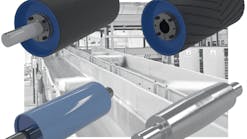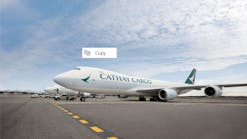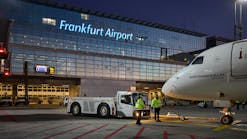Aug. 29--An airplane was climbing in the direction of thunderstorms vaulting across northeast Indiana when an air traffic controller radioed the pilots to recommend a course change toward smoother air.
Normally such advice would be heeded, but the purpose of the storm-chasing flight this week was to test a new type of onboard weather radar that major airlines will be buying for thousands of new aircraft in the coming years to comfortably maneuver around storms while saving fuel, improving on-time arrivals and substantially reducing encounters with turbulence.
So the Honeywell Aerospace flight crew kept flying toward the storms, explaining to the controller that the mission was to take the Convair 580 up to the edges of the worst weather, which were vividly displayed in yellow and red on the cockpit screen, and skirt it for a while until weaving a path through pockets of calm air. All of it was outlined by a new 3-D weather radar system made by Honeywell called IntuVue.
The ride in the rugged 62-year-old turboprop got increasingly bumpy as the plane dipped and rose through swirling air amid a pelting rain.
Honeywell lead test pilot Randy Moore lifted one hand off the control yoke to point out ice crystals that were beginning to form on the plane's windscreen and its wings, a sign for the pilot to steer toward friendlier skies.
Moore increased engine thrust and banked the plane to the northwest, outrunning the center of the approaching storm. In a moment visible on both the weather radar screen and through the plane's windscreen, the dark clouds parted and the Convair threaded the needle of bright blue sky.
The flight plan out of Midway Airport was unlike any that a commercial airline pilot would ever file with air traffic control. But it validates a technology airlines are eager to expand to combat weather-related delays, which federal officials say have totaled the equivalent of more than 106 days at Chicago's two airports through the first half of this year and cost the industry billions of dollars annually nationwide.
The new generation of weather radar, manufactured in separate versions by Honeywell and its competitor Rockwell Collins Inc., is designed to reduce those delays with its ability to scan for trouble across a wide swath of skies hundreds of miles ahead of the plane.
It represents a technological leap ahead of onboard systems that date to the 1960s and provide a narrower view of weather conditions and increase the pilot workload.
Those legacy systems require a pilot to first turn knobs to manually tilt and retilt the disk-shaped radar antenna housed in the nose of the plane, then interpret the individual radar slices of weather displayed to get an overall understanding -- while at the same time flying the plane.
The IntuVue model RDR-4000 3-D radar on the Honeywell test plane carries out seven tilts of the system's 30-inch antenna about every 30 seconds, said Jeff Hester, a technical sales manager at Honeywell. It is rated to probe as far as about 370 miles straight ahead to show the en route weather picture, detect turbulence and predict lightning and hail, as well as automatically scan from the ground up to 60,000 feet to provide information targeted at various altitudes, according to Honeywell.
Pilots do not fly into dangerous weather that could compromise their ability to return to the ground, at least not if they can see it on cockpit weather displays. And though Tuesday's test flight navigated a lot of airspace marked yellow, signifying moderate thunderstorms, at no time did Moore risk straying into red areas, representing the most severe conditions, or magenta, the symbol for turbulence.
As the ice crystals formed on the windscreen, co-pilot Markus Johnson turned to this reporter, seated in the cockpit's jump seat.
"You haven't spilled your drink yet, have you?" said Johnson, chief pilot of flight test operations at Honeywell. "We are just creating a little mixing action for the ice cubes."
Extremely choppy air sometimes sneaks up on flight crews because weather detectors in the noses of planes miss volatile air along the flight path. That's often due to older weather systems scanning only a narrow radar beam. The weather antenna must be manually tilted up and down by the nonflying pilot. Over-scanning or underscanning results in a less-than-complete picture of the sky yonder.
"One of the things this new radar does a better job of is helping pilots interpret distant weather possibly sooner, which definitely could save you some time and fuel and potentially increase safety by making a decision sooner on circumnavigating a nasty thunderstorm," said Southwest Airlines Capt. Bill Lusk, manager of daily operations for the carrier.
"It keeps both pilots in the game by lessening the fine-tuning that you would be doing manually to understand the complete picture of the weather," Lusk said.
The weather map on IntuVue's screen distinguishes weather conditions that will affect the plane up to about 4,000 feet above and below its current route from activity that is farther away. Weather conditions along the plane's route are displayed in solid colors, while more distant conditions are shown in hash mark colors, to help pilots determine whether rerouting is necessary.
"If you can't see out the window and pick your way around the storm, such as at night, in bad visibility, rain, clouds, stormy weather, then the picture you see on the radar display represents what is outside and is so accurate and so real that you can fly by that. And that's the whole point," Johnson said.
The IntuVue system is being outfitted onto many planes coming off the Boeing and Airbus assembly lines. Southwest, which flies Boeing 737s, was the first U.S. customer to deploy the system with an upgrade that is certified to predict hail and lightning five to 10 minutes before it occurs as well as detect turbulence that is up to 69 miles away, the airline and Honeywell said.
And United Airlines will have the system on its Airbus A350-1000 planes when the Chicago-based carrier takes delivery of 35 of the jetliners in 2018, a United spokeswoman said.
The Boeing 787 Dreamliner, which is operated by United and other airlines, is outfitted by Boeing with the Rockwell weather product.
Currently, about 2,000 planes flown by more than 70 airlines worldwide are outfitted with IntuVue, with about 2,500 more on order, Hester said.
An earlier model of IntuVue was first offered in 2006 on Boeing 777 aircraft. Since then it has been certified by the Federal Aviation Administration to also fly on 737 models, as well as on all Airbus planes. It is also offered on some business jets, and the Pentagon deploys it on military aircraft, Honeywell said.
Honeywell said it has demonstrated more than a 50 percent reduction in turbulence-related incidents, compared with conventional weather radar.
"Some of the old systems can see weather out to 300 nautical miles, but it is a pencil-thin beam. If a pilot points the antenna higher or lower than the location of a storm, you could miss it," said Greg Schauder, product manager for IntuVue.
He said IntuVue has demonstrated a 26 percent improvement in weather avoidance and enhanced pilot decision-making.
Updates to IntuVue are coming next year and in 2017, Hester said. One new feature will be the ability to detect ice that can become attached to the inside of jet engines at high altitudes, he said.
Honeywell declined to cite a specific unit price for the IntuVue system for airliners, saying it is based on various factors. But Schauder said the cost "is in the hundreds of thousands of dollars" per device.
American Airlines, which is second to United in terms of flights at O'Hare International Airport, is equipping its new 737s with a next-generation weather radar, called the MultiScan ThreatTrack, manufactured by Rockwell Collins.
American, which previously used Honeywell weather products, selected the new Rockwell system because of its ability to conduct an in-depth analysis of individual thunderstorm cells, said American Capt. Brian Will, the airline's director of airspace optimization and aircraft technologies.
Will cited a recent trip he flew to Central America during which the radar system helped him avoid diverting to another airport.
"I was flying a 737 to Belize, the weather service's forecast for the Yucatan Peninsula wasn't good and after sitting on the ground for one hour burning fuel, we took off," Will said.
A line of thunderstorms quickly intensified.
"We were looking to deviate about 200 miles to the east, but we didn't have enough gas," he said. "We turned the plane toward the line of weather and we found an area that the weather radar indicated was safe. We flew through it and there was not a ripple or a bump."
Twitter @jhilkevitch
Copyright 2014 - Chicago Tribune




